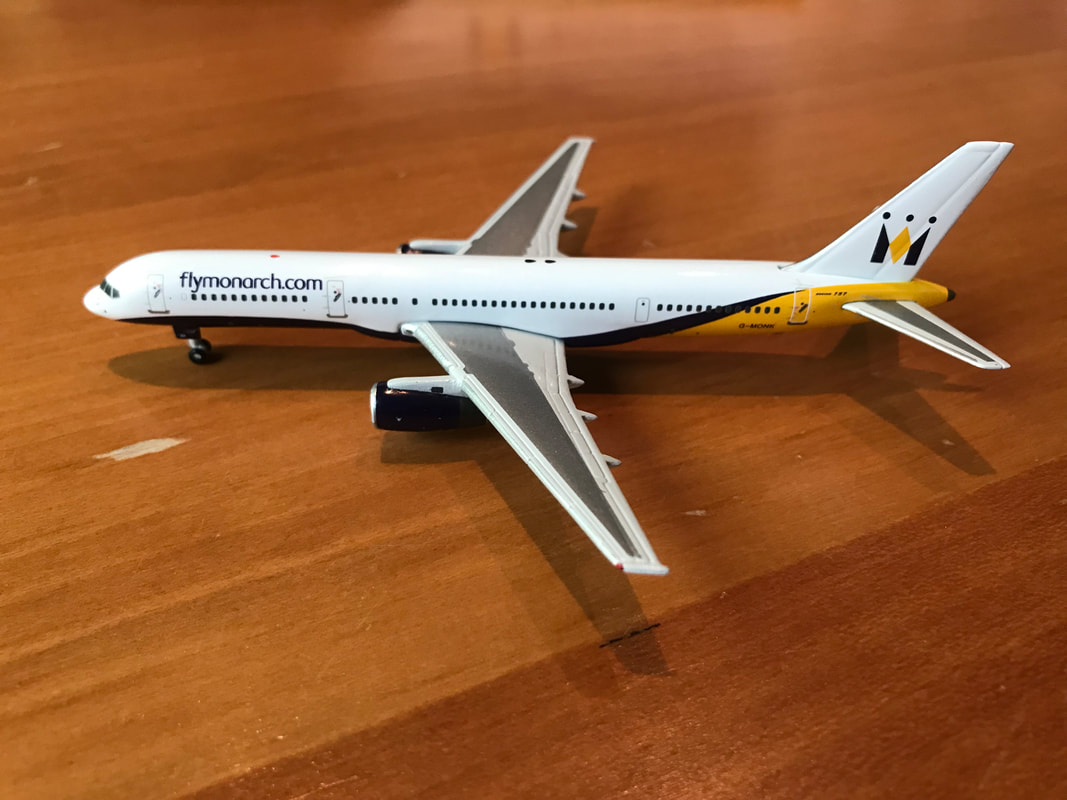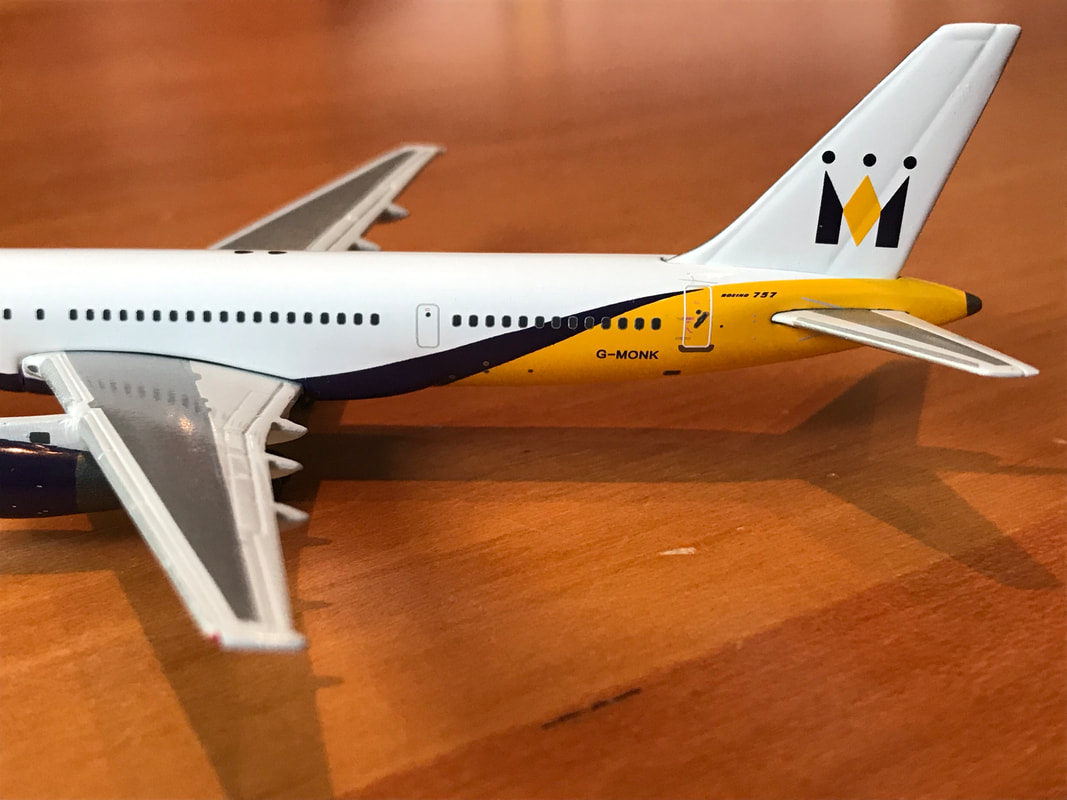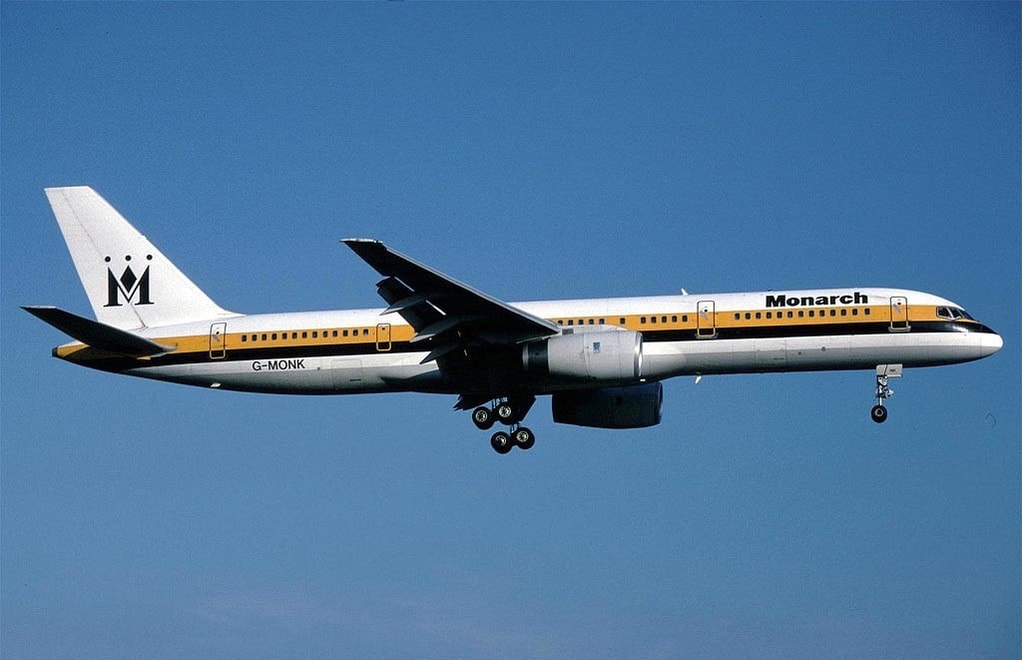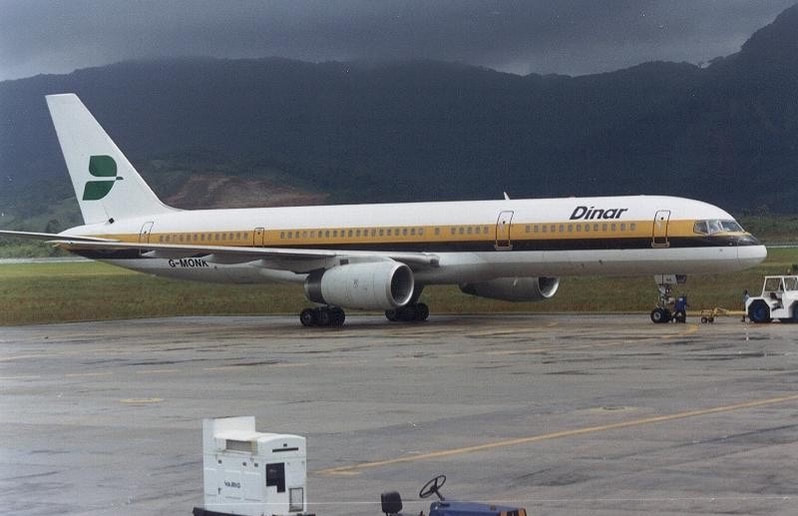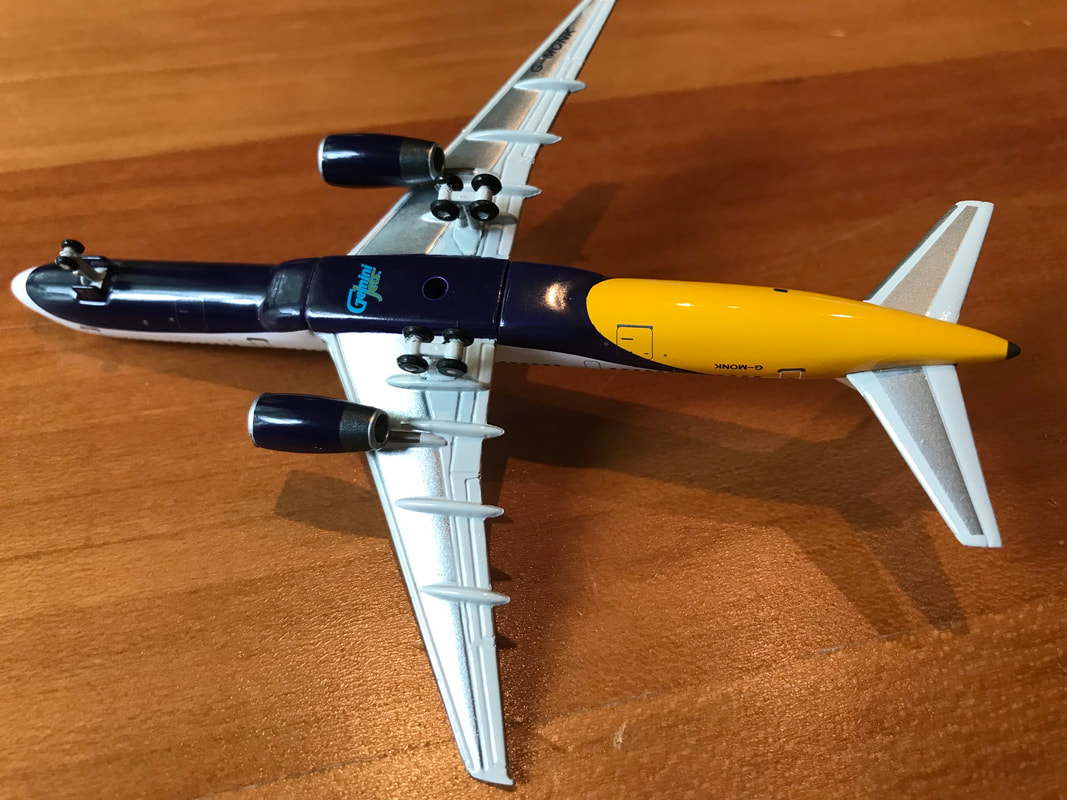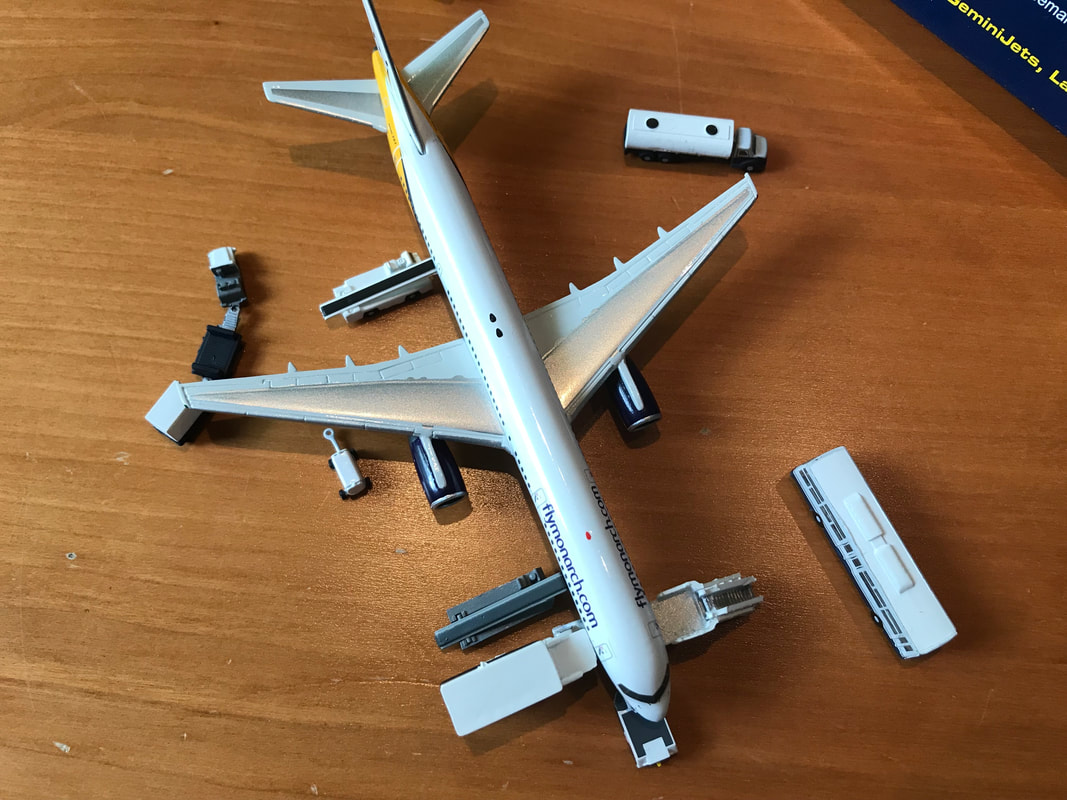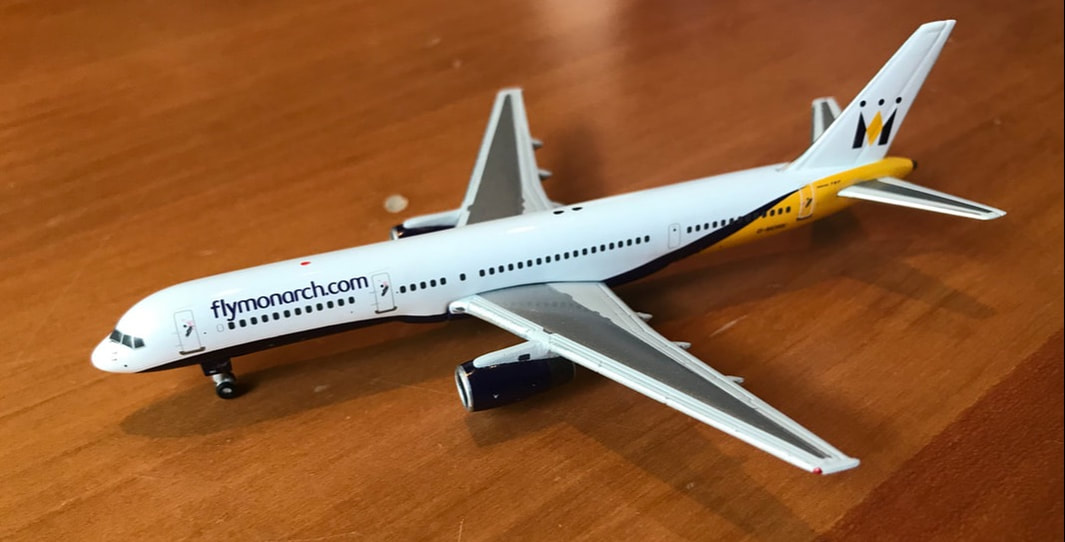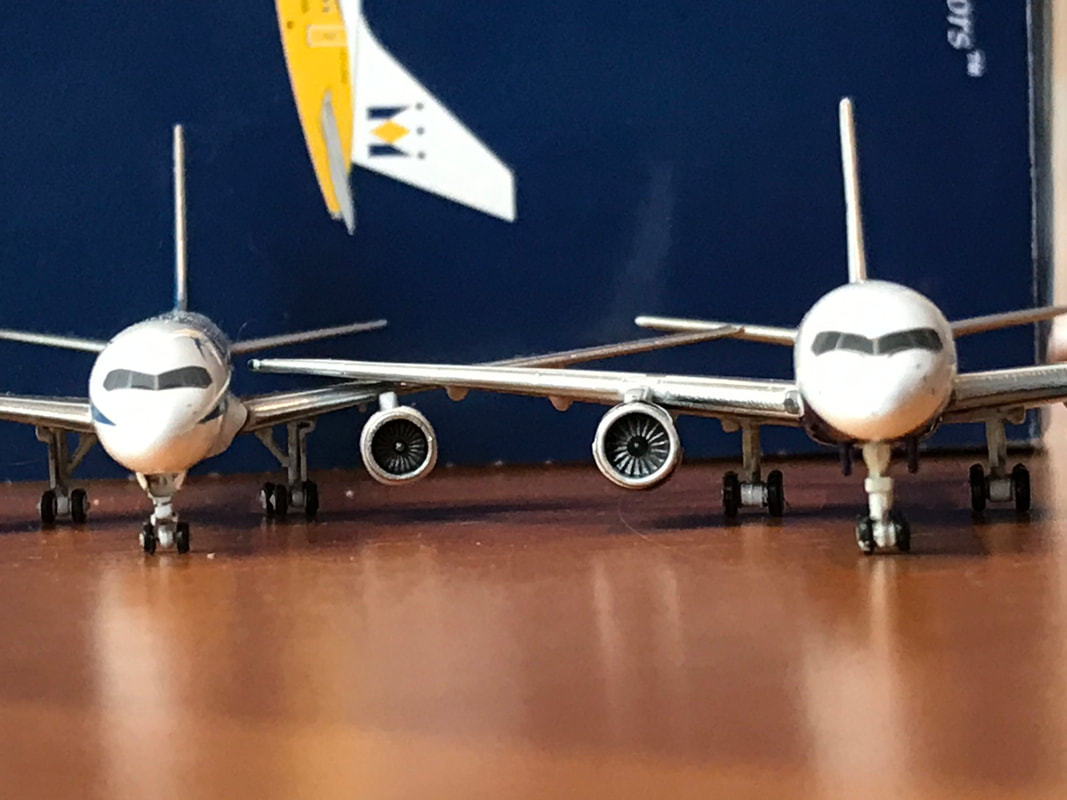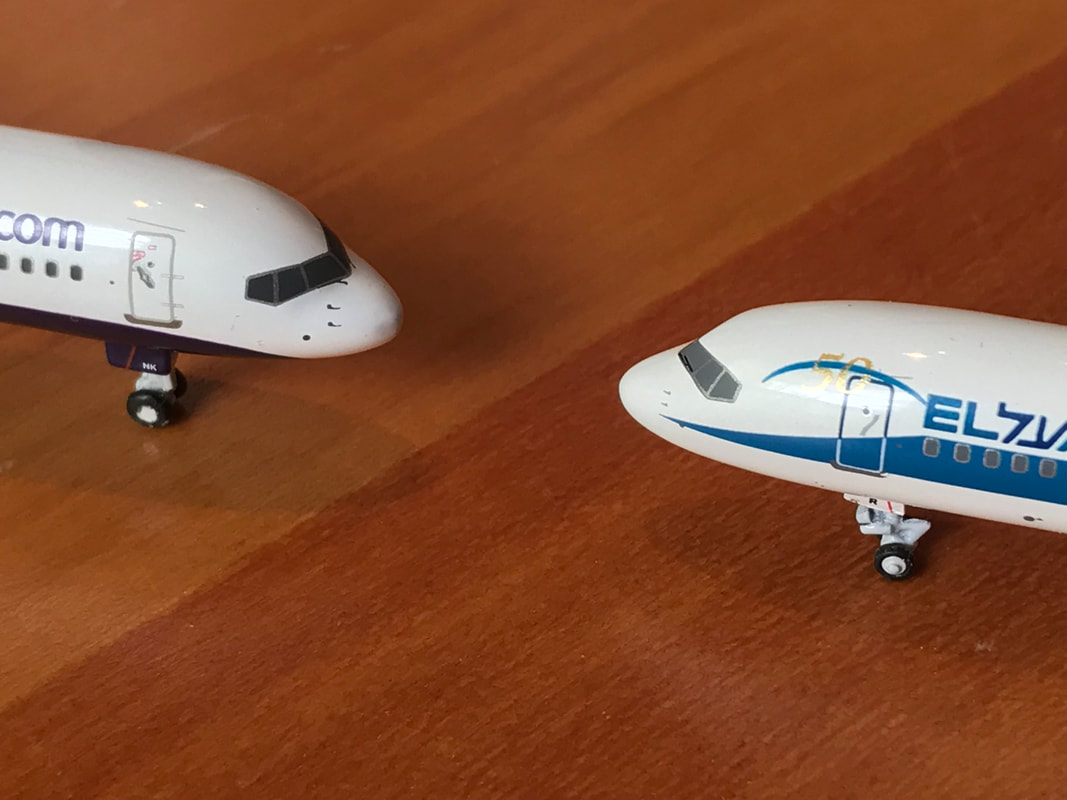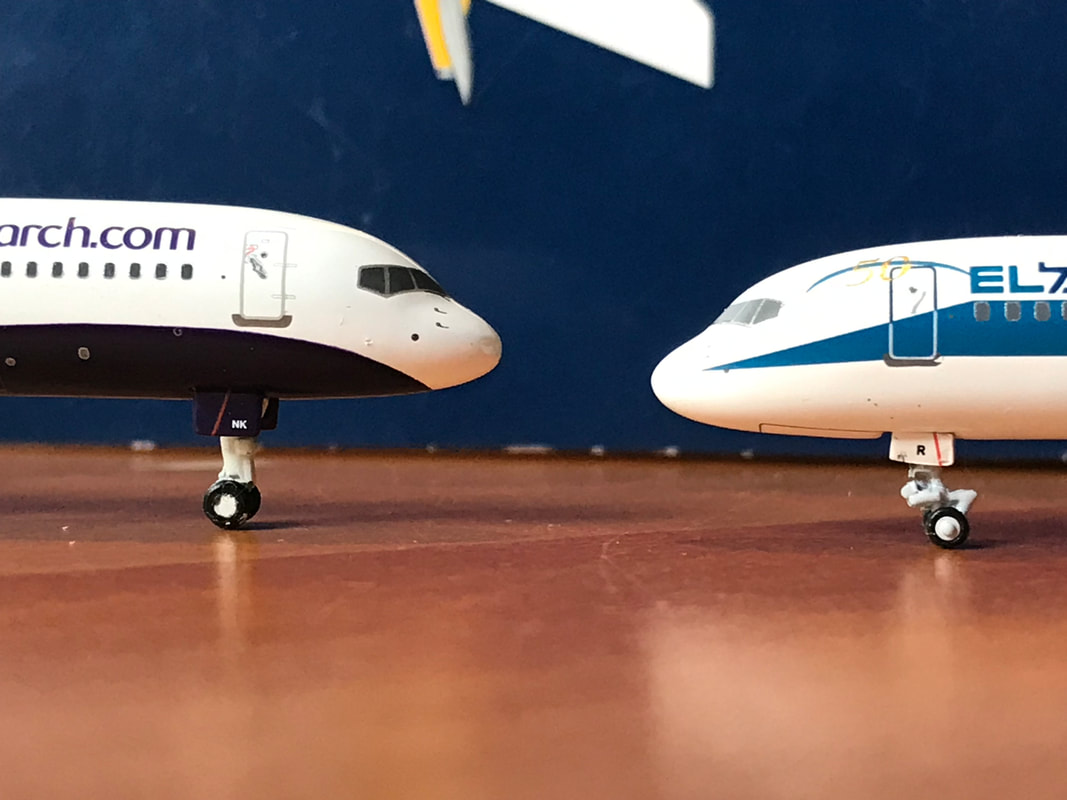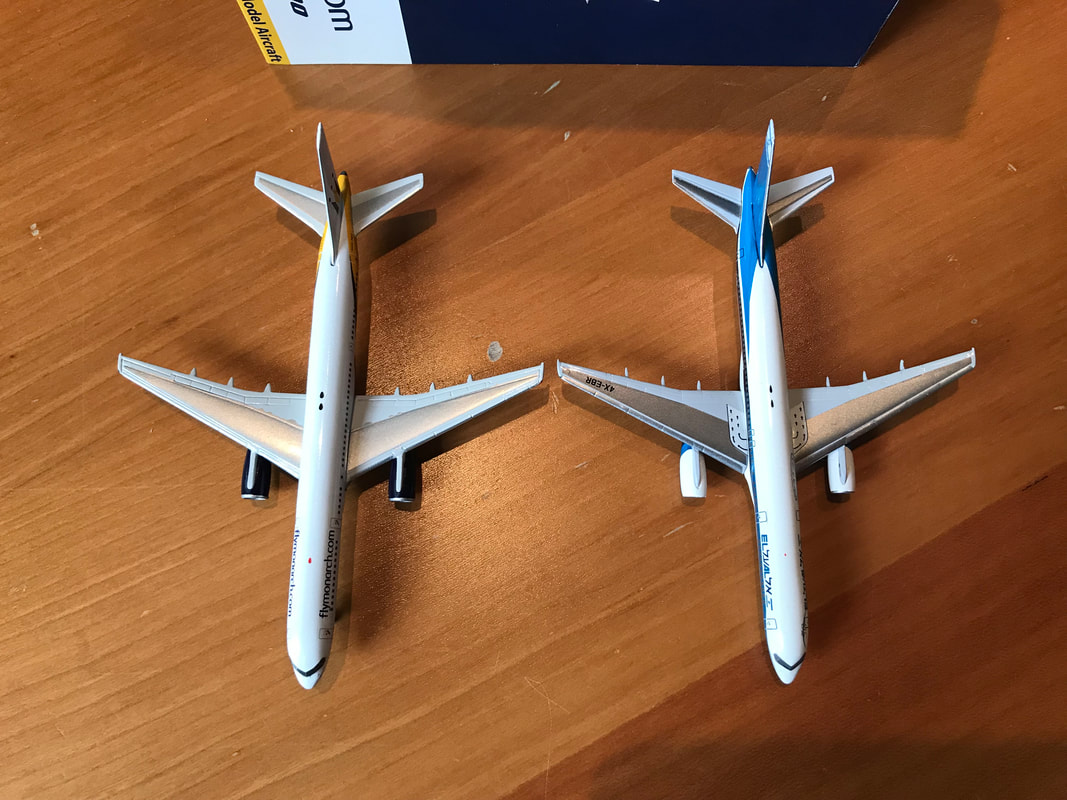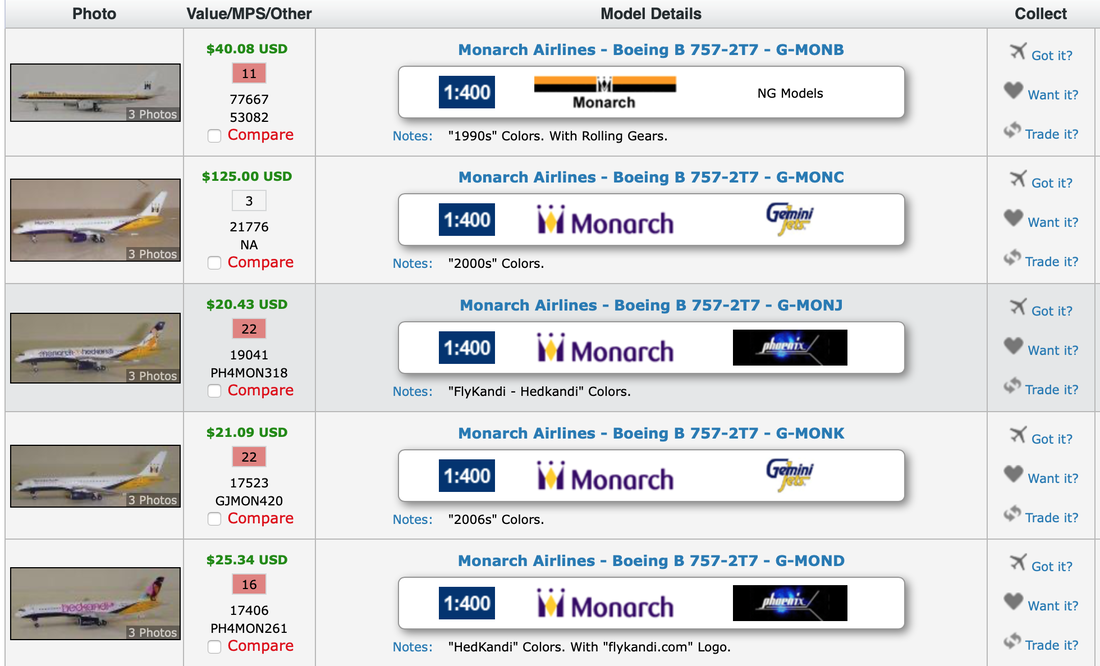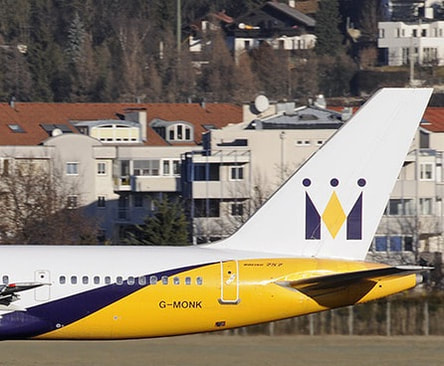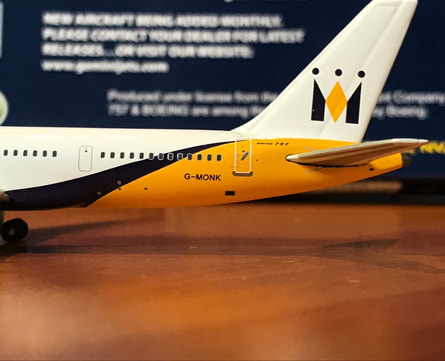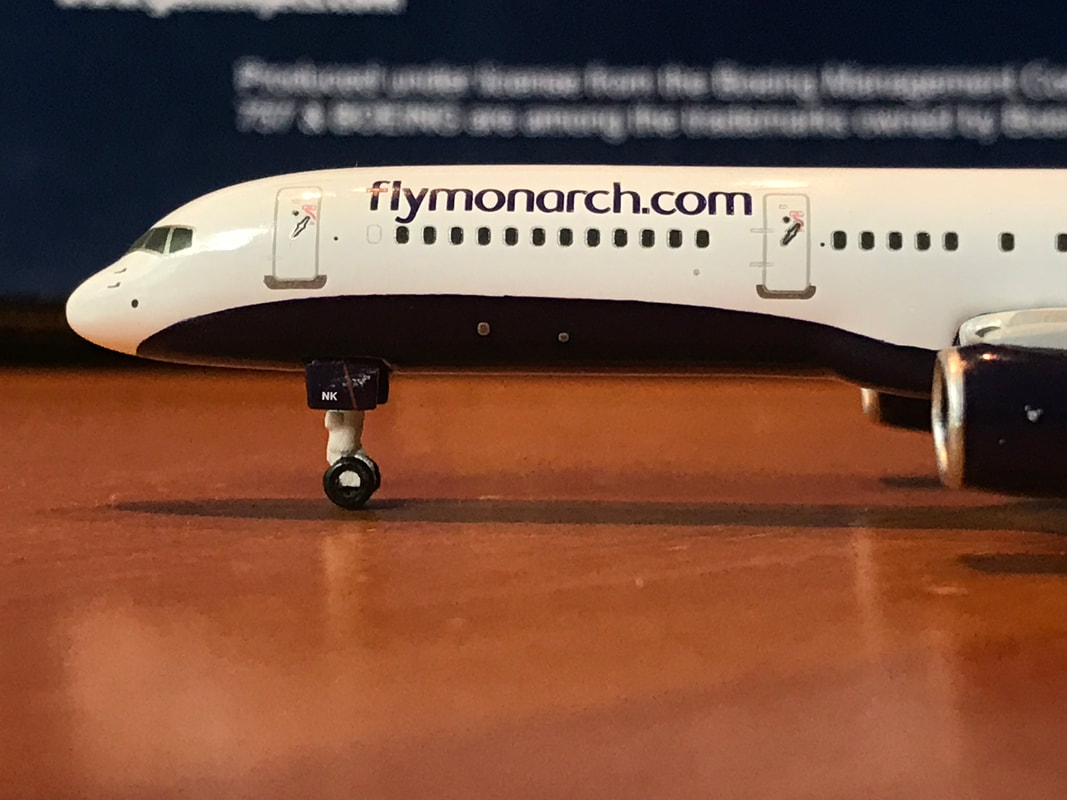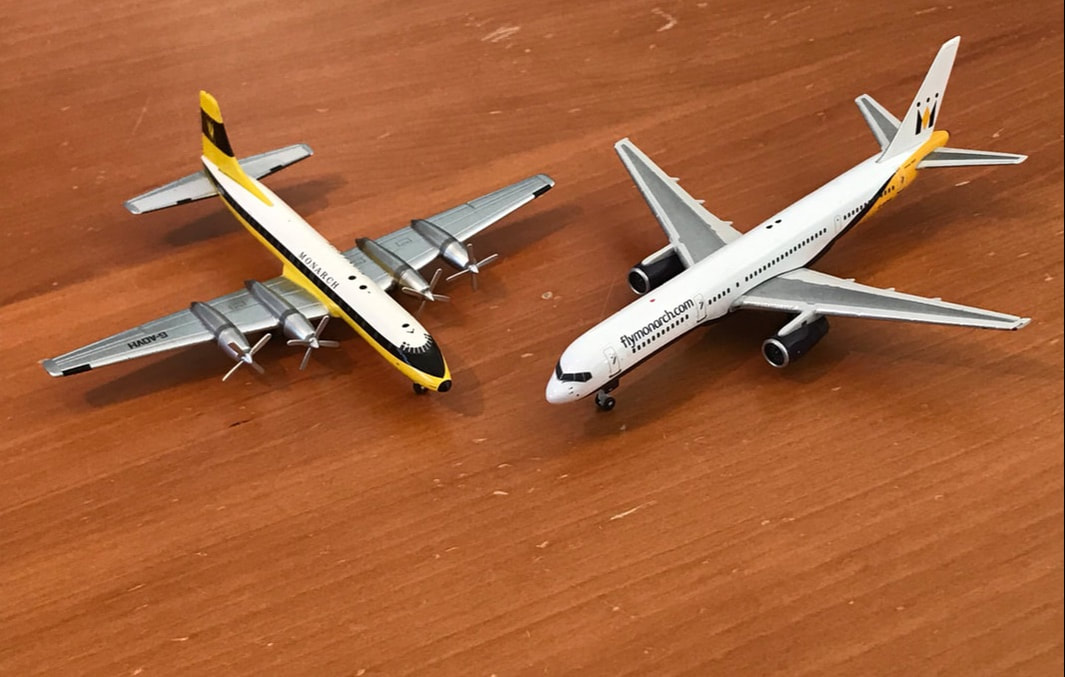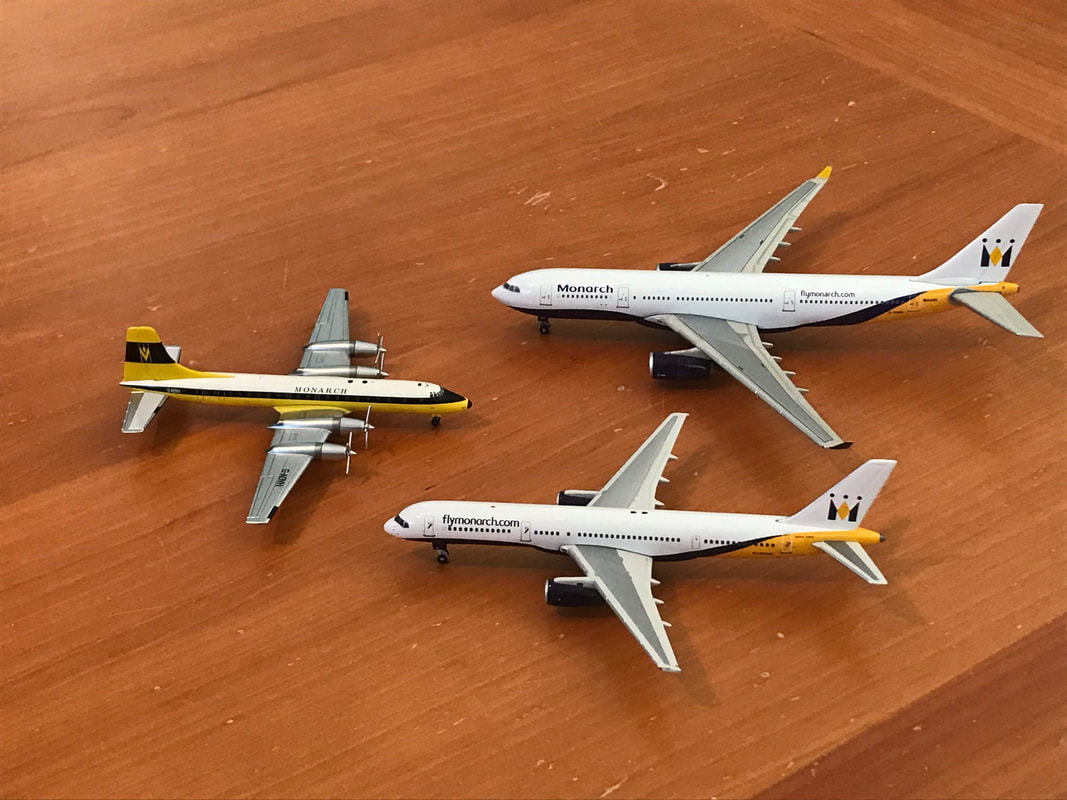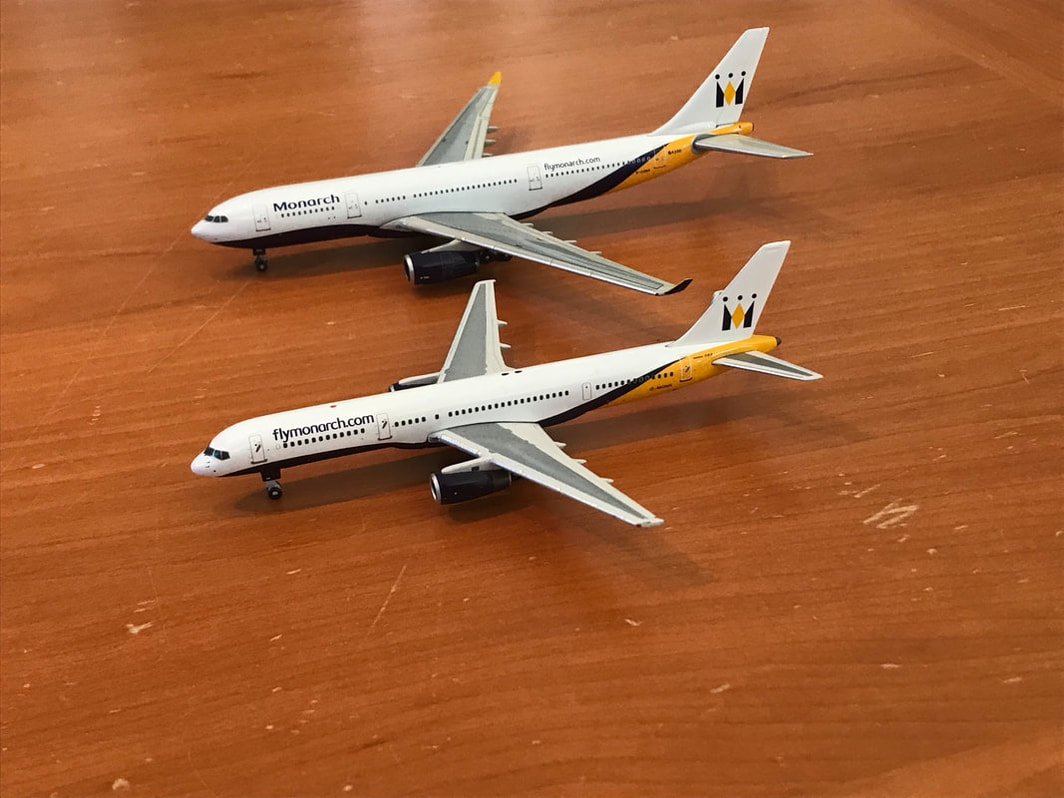Monarch Airlines Boeing 757-2T7, 2006 LiveryGemini Jets Part Number: GJMON420
|
Manufacturer: Gemini Jets
Released: 2007 Registration: G-MONK Published: 12/11/20 |
First Impressions:
On October 2nd 2017 Monarch Airlines flew its final regular service flight to Tel Aviv and ceased all operations leaving thousands stranded across Europe and the world. I'm sure this disastrous ending was not what Bill Hodgson and Don Peacock had in mind when they started Monarch in 1967.
At its heart, Monarch was always designed to serve the middle class. It began as an airline intent on getting families to vacation destinations and continued to be driven by this market until and beyond 2004 when it became a regularly scheduled LCC. Few people know that upon the acquisition of 757-200s to it's fleet that were ETOPS certified, Monarch had the first British operated twin engine jet to cross the Atlantic Ocean with passengers (Luton to Orlando) in 1988 with one of these 757s.
Over the last 20 years or so Gemini has basically used the same general 757 mould that has endured several changes and adjustments. Gemini's first 757 casting which features both cradle fastened wings and horizontal stabilizers has been tweaked a number of times and is still the basis for its current 757. Gemini updated this casting around 2002 by making the fuselage one single piece with slot-in horizontal stabilizers yet still keeping the cradle mounted wing chassis which is a feature that still helps to easily identify the mould in a lineup . That makes this first refinement of the original mould also easy to grade and compare to more modern offerings.
On October 2nd 2017 Monarch Airlines flew its final regular service flight to Tel Aviv and ceased all operations leaving thousands stranded across Europe and the world. I'm sure this disastrous ending was not what Bill Hodgson and Don Peacock had in mind when they started Monarch in 1967.
At its heart, Monarch was always designed to serve the middle class. It began as an airline intent on getting families to vacation destinations and continued to be driven by this market until and beyond 2004 when it became a regularly scheduled LCC. Few people know that upon the acquisition of 757-200s to it's fleet that were ETOPS certified, Monarch had the first British operated twin engine jet to cross the Atlantic Ocean with passengers (Luton to Orlando) in 1988 with one of these 757s.
Over the last 20 years or so Gemini has basically used the same general 757 mould that has endured several changes and adjustments. Gemini's first 757 casting which features both cradle fastened wings and horizontal stabilizers has been tweaked a number of times and is still the basis for its current 757. Gemini updated this casting around 2002 by making the fuselage one single piece with slot-in horizontal stabilizers yet still keeping the cradle mounted wing chassis which is a feature that still helps to easily identify the mould in a lineup . That makes this first refinement of the original mould also easy to grade and compare to more modern offerings.
|
The Box:
Gemini presents this 2007 issue 757 in its updated and current packaging featuring a open flap viewing lid, standard card stock box, and the usual transparent lid over blue cradle. The inner flap provides the usual tech specs of the 1/1. It also includes the usual nice overview of the physical dimensions of the aircraft. |
|
First Seen:
Boeing 757 airframe number 172 was delivered to Monarch Airlines in 1988 and spent its first decade of service with Monarch. Starting in 1998, it seems G-MONK was seasonally leased to Dinar Lineas Aereas to fly South American charters but returned to the fleet permanently by the end of the year 2000. |
|
Last Seen:
According to a few sources, G-MONK was pulled from service in November of 2014 and scrapped a few months later in April of 2015. At just over 26 years of age this aircraft undoubtably helped families all over the world create lifelong memories of family vacations and assisted Monarch in becoming a primer choice for jet setters and holiday makers alike. |
Construction:
As previously mentioned, this model represents' Gemini's first refinement or "2.0" version of it's original and as far as I know, current mould. Additionally, this mould has experienced continued refinement with the addition of things like rolling gears, and antennas. While new moulds by different manufacturers like Next Generation Models have more recently been developed and truly make this mould obsolete in a comparison, there's no doubt that this is a 757-200.
As previously mentioned, this model represents' Gemini's first refinement or "2.0" version of it's original and as far as I know, current mould. Additionally, this mould has experienced continued refinement with the addition of things like rolling gears, and antennas. While new moulds by different manufacturers like Next Generation Models have more recently been developed and truly make this mould obsolete in a comparison, there's no doubt that this is a 757-200.
As was the case with most 1/400 scale model airliners released in the year 2007, a more simple design meant that construction was usually a non-issue. All the main pieces to the model are soundly fit together and 13 years later, the glue holds firm. The gears, while simple by 2020's standards are firmly attached and level.
The wings which as mentioned are a single piece are really nicely moulded. Besides them being quite a bit more chunky than they should be, their shape and dimensions are very good. The engine pylons are part of the wing mould and the cowlings glued to them are firmly and neatly fastened. The fan blades inside the cowlings are nicely detailed and appear fairly close to scale.
The wings which as mentioned are a single piece are really nicely moulded. Besides them being quite a bit more chunky than they should be, their shape and dimensions are very good. The engine pylons are part of the wing mould and the cowlings glued to them are firmly and neatly fastened. The fan blades inside the cowlings are nicely detailed and appear fairly close to scale.
Overall, the build quality for something made over 13 years ago is satisfactory. This is a wonderful homage to one of the most identifiable euro non-legacy carriers of the early 2000's. It represents a day when construction in 1/400 was rarely an issue.
Accuracy:
When it comes to identifying how well the 1/400 compares to the 1/1, overall shape and moulding are of paramount importance. So, is this a 757-200?
When it comes to identifying how well the 1/400 compares to the 1/1, overall shape and moulding are of paramount importance. So, is this a 757-200?
I believe it most certainly is. Key features of the 757 include a unique nose profile. It also should have a long slender fuselage. A tall front gear leg and double-boggie main gears. A proper -200 has all of these things plus (sometimes) 2 Rolls-Royce RB11 turbine engines mounted below each wing. All of these things mean that the 757-200 presented here is in order. Gemini does a great job to include these physical features plus many more details of the -200 are well captured.
A quick comparison of the nose profile. 1/1 to NG/Aeroclassics to Gemini 2.0
There are many areas that I could dissect to point out the true flaws of the mould compared to how good the newer NG is. But if the NG mould had never come along, this mould would firmly maintain its place in my collection. Its biggest fallacies are truly a more chunky and robust appearance meaning the mould is only limited by the innovation at the time of its creation. The updates to pylons, gears and the addition of antenna on the NG render the GJ 2.0 obsolete but by no means is it hard to look at in context. Nor should it be avoided by collectors when the aircraft they are looking for is only represented by the GJ 2.0 mould or otherwise.
Paint and Printing:
This model is the only 1/400 scale 757-200 in Monarch's "flymonarch.com" scheme, and one of 5 total choices for a 757-200 representing the type in the historical fleet. So, there isn't a lot to compare this model to, and in my opinion, based on the age and one of a kind paint scheme, it is relatively difficult to find. For this reason also I believe, is reason enough for NG Models to reproduce this scheme as well as the standard Monarch scheme in final colors, I'm sure it would be well sought after.
This model is the only 1/400 scale 757-200 in Monarch's "flymonarch.com" scheme, and one of 5 total choices for a 757-200 representing the type in the historical fleet. So, there isn't a lot to compare this model to, and in my opinion, based on the age and one of a kind paint scheme, it is relatively difficult to find. For this reason also I believe, is reason enough for NG Models to reproduce this scheme as well as the standard Monarch scheme in final colors, I'm sure it would be well sought after.
Besides the point of uniqueness, the quality of the paint job on this model is good, and it has stood up well to years of both storage/cradle and shelf wear. The usual white base coat is glossy and smooth. The other painted layers of the Monarch scheme as well as the lift surfaces and stabs are done properly as well with no blemishes or smudges to speak of.
Subtracting my total lack of photography skills, it's still apparent that Gemini have the most crucial part of this scheme mostly right. The Monarch crown is shaped ad sized very well and again, despite the poor lighting, is the correct colors. The only critique I have is that the golden pattern on around the tail section of the fuselage doesn't extent forward towards the rear of the wing base as far as it should. All other titles and windows on the tail section of the aircraft are happily really good, and to scale.
The forward section of the aircraft contains less fanfare and detail compared the rear section. The most glaring inaccuracy here is the rise and fall of the humbral 15/midnight blue belly paint. It just doesn't follow the correct arcs and takes away from all the other properly done details like the doors, windows, and titles here in the forward section. The worst of all is the way it ceases too quickly before reaching the radome. Perhaps the titles are a tad too thick, but the font and placement is good. Overall, the colors and details make this more than passable for the time being.
Conclusion:
Until NG decides to take this aircraft on as a new project, Gemini's version of G-MONK is here to stay in my collection. It more than represents an airline that was on the verge of greatness. Monarch had 787s on order and was close in so many ways to avoiding it's eventual collapse but a string of events like the delay of said 787 order and the rapid rise of competition from the likes of Ryanair and EasyJet created razor thin margins in the LCC business. A business that Monarch became a part of as a result of its growth as a charter airline. What could have been for the airline is a sad thought. But gladly its history brings beautiful hues of blue and yellow to 1/400.
Until NG decides to take this aircraft on as a new project, Gemini's version of G-MONK is here to stay in my collection. It more than represents an airline that was on the verge of greatness. Monarch had 787s on order and was close in so many ways to avoiding it's eventual collapse but a string of events like the delay of said 787 order and the rapid rise of competition from the likes of Ryanair and EasyJet created razor thin margins in the LCC business. A business that Monarch became a part of as a result of its growth as a charter airline. What could have been for the airline is a sad thought. But gladly its history brings beautiful hues of blue and yellow to 1/400.
As a final thought, there are many 1/400 models that are out there representing Monarch, but many are outdated, or on sub-superior moulds. I think there is a lot of opportunity to revisit Monarch as a sellable 1/400 model. There is something I like to call the "fleet effect." It's the sensation that's created when observing a group of models together all wearing the same livery. Any livery you choose from this airline, group a few together and enjoy. Thanks for reading.
Proudly powered by Weebly
